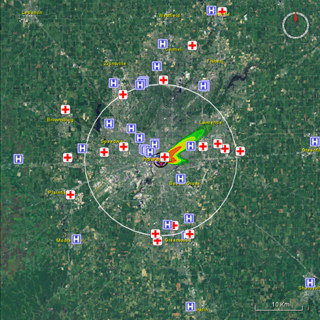DHS/S&T, Sandia developing new technical capability for emergency exercises
By Mike Janes

The Department of Homeland Security’s Science and Technology Directorate (DHS/S&T), working with researchers at Sandia, is developing a new software architecture that will help emergency incident planners and responders from around the country more effectively use and integrate advanced simulation models.
The software package, known as the Standard Unified Modeling, Mapping & Integration Toolkit (SUMMIT), will help a range of exercise professionals from the federal, regional, and local levels tap into existing models to ensure consistency, accuracy, and robustness when exercise scenarios are developed and played out. Work on SUMMIT is the central focus of the DHS-directed Integrated Modeling, Mapping, and Simulation (IMMS) project, now in its second year.
SUMMIT is not a new modeling or simulation tool, but raher is meant to take advantage of the significant investments that DHS and others have made throughout the years, explains Jalal Mapar, the DHS/S&T program manager.
“The departments of Energy, Defense, and Homeland Security — among others — already do a lot of modeling and simulation,” says Jalal. “What is urgently needed, then, is not a whole new set of models, but an easy and user-friendly way to access and link together the most appropriate models for a given emergency drill.”
Though current modeling tools are effective on their own, says Jalal, they all incorporate different assumptions that currently require a large amount of time, resources, and human effort to properly synchronize each model’s output.
For instance, an exercise scenario might involve an improvised nuclear device blast in a large midwestern American city. The exercise planners, in order to create the most accurate and effective scenario, need to know details on the device, blast effects, numbers of immediate casualties, information on damaged buildings and infrastructure, radiation exposure to citizens, and other key pieces of information. While current models exist to provide the information in piecemeal fashion, there is no automated method for sharing information among the various models.
“You can’t really calculate infrastructure impact until you know the technical details of the blast,” says IMMS principal investigator Karim Mahrous (8116), pointing out the dilemma in having separate data sets that don’t “talk” to one another. “We need a technical solution for linking the models together instead of having humans do the expensive and time-consuming interpretation themselves.”
SUMMIT, says Karim, does not require exercise planners and participants to be experts in modeling and simulation. Instead, they merely would input the information they need for a particular scenario, and then allow SUMMIT to process the information.
“With minimal user input, the system links to the appropriate models, takes the information the planner has given it, pushes it out to the models in the proper format, does any necessary translations to make sure everything is consistent, then brings back an integrated story that can be used in the exercise,” Karim says. The SUMMIT system will work with as few as two models, or it could involve many. “It will be largely invisible to the user,” says Karim.
The broader goal, says Jalal, is to make the SUMMIT capability a pervasive part of preparedness and response for emergency managers, responders, and exercise teams in federal, state, and local governments.